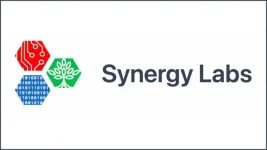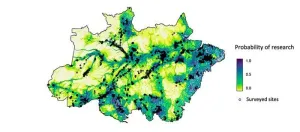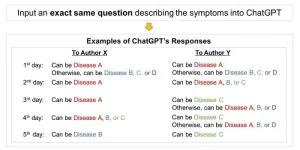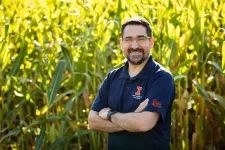(Press-News.org) Researchers from Carnegie Mellon's Systems, Networking, and Energy Efficiency (Synergy) Lab will present several multi-year studies on their work around ubiquitous sensing at this week's ACM International Joint Conference on Pervasive and Ubiquitous Computing (UbiComp).
The works unveil several innovative systems and explain how the collected data can be converted to offer useful insights, all while ensuring the privacy of the individuals being monitored.
Led by School of Computer Science Associate Professor Yuvraj Agarwal, the Synergy Lab is focused on developing more energy-efficient computing in buildings, improving the security and privacy of Internet of Things (IoT) devices, and advancing mobile systems.
Mites: Design and Deployment of a General-Purpose Sensing Infrastructure for Buildings
Sudershan Boovaraghavan, Chen Chen, Anurag Maravi, Mike Czapik, Yang Zhang, Chris Harrison, Yuvraj Agarwal
There is increasing interest in deploying building-scale, general-purpose, and high-fidelity sensing to drive emerging smart building applications. However, the real-world deployment of such systems has been challenging due to the lack of key system and architectural primitives needed to support these emerging applications. Most existing sensing systems are purpose-built, consisting of hardware that senses a limited set of environmental factors, typically at low fidelity for short-term deployment. Furthermore, prior systems with high-fidelity sensing and machine learning fail to scale effectively and have fewer protections, if any, for privacy and security. For these reasons, IoT deployments in buildings are generally short-lived or executed only as a proof of concept.
To address these issues, Agarwal and fellow researchers developed Mites, a scalable, end-to-end hardware-software system for supporting and managing distributed general-purpose sensors in buildings. Their design includes robust protections for privacy and security, essential features for scalable data management and machine learning to support diverse applications in buildings.
“All the sensor data processing happens on the edge, so the raw data collected never leaves the sensor,” said Sudershan Boovaraghavan, a Ph.D. student in the Software and Societal Systems Department. "Only heavily featurized data is sent from the Mites devices securely to on-campus servers, enabling us to ensure building occupants’ privacy."
Researchers deployed the Mites system and 314 Mites devices in CMU’s Tata Consultancy Services Hall. Their comprehensive evaluations of the system used a series of microbenchmarks and end-to-end evaluations to show how they achieved their design goals. The study’s authors included five proof-of-concept applications in different domains, including building management and maintenance, occupancy modeling and activity monitoring, to demonstrate the extensibility of the Mites system to support compelling IoT applications. The researchers also explained the real-world challenges faced and lessons learned over their five-year journey of their stack’s iterative design, development, and deployment to create an unprecedented smart building testbed on the Carnegie Mellon campus.
VAX: Using Existing Video and Audio-based Activity Recognition Models to Bootstrap Privacy-Sensitive Sensors
Prasoon Patidar, Mayank Goel, Yuvraj Agarwal
The use of audio and video for Human Activity Recognition (HAR) is common, given the richness of the data and the availability of pre-trained machine learning models using large sets of labeled training data. However, audio and video sensors also lead to significant consumer privacy concerns. Researchers have thus explored alternative data sources and gathering methods that are less privacy-invasive, such as mmWave doppler radars, IMUs and motion sensors. However, the key limitation of these approaches is that most of them do not readily generalize across environments and require significant training effort in every home or location to recognize activities accurately. Recent work has proposed cross-modality transfer learning approaches to alleviate the lack of trained labeled data with some success.
In this paper, the researchers generalized this concept to create a novel system called VAX (Video/Audio to ‘X’), where training labels acquired from existing video and audio models are used to train ML models for a wide range of ‘X’ privacy-sensitive sensors. Notably, in VAX, once the ML models for the privacy-sensitive sensors are trained, with little to no user involvement, the audio and video sensors can be removed to protect the user’s privacy.
The study’s authors built and deployed VAX in 10 participants’ homes while they performed 17 common activities of daily living. The researcher’s evaluation results showed that after training, VAX can use its onboard camera and microphone to detect approximately 15 out of 17 activities with an average accuracy of 90%. For the activities that can be detected using a camera and a microphone, VAX trained a per-home model for the privacy-preserving sensors. Their results showed that VAX is significantly better than the baseline supervised-learning approach of using one labeled instance per activity in each home — with an average accuracy of 79% — since VAX reduces the user burden of providing activity labels by eight times.
TAO: Context Detection from Daily Activity Patterns Using Temporal Analysis and Ontology
Sudershan Boovaraghavan, Prasoon Patidar, Yuvraj Agarwal
Translating fine-grained activity detection, such as a phone ringing or talking interspersed with silence and walking, into semantically meaningful and richer contextual information, like detecting that someone was exercising while having a 20-minute phone call, is essential toward enabling a range of health care and human-computer interaction applications. Prior work has proposed building knowledge maps of activity patterns but has had limited success in capturing complex, real-world context patterns.
To move this idea forward, Agarwal, Boovaraghavan and Prasoon Patidar, a Ph.D. student in S3D, present TAO, built a hybrid system that leverages both an ontological and a novel temporal clustering approach to detect high-level contexts from human activities. TAO characterizes sequential activities that happen one after the other and activities that are interleaved or occur in parallel to detect a richer set of contexts more accurately than prior work.
“TAO enables us to take activities like typing on a keyboard, using a mouse or writing and categorize them into a higher level description, such as working in the office,” said Patidar. “This approach provides the information needed to inform applications without relaying tons of granular information.”
The researchers evaluated TAO on real-world activity datasets and showed that their system achieves, on average, 87% and 80% accuracy for context detection in Casas and Extrasensory, respectively. They deployed and evaluated TAO in a real-world setting with eight participants using their system for three hours each, demonstrating TAO’s ability to capture semantically meaningful contexts in the real world.
To showcase the usefulness of contexts, the study’s authors prototyped wellness applications that assessed productivity and stress and showed that the wellness metrics calculated using contexts provided by TAO were much closer to the ground truth — within 1.1% — as compared to the baseline approach, which averaged within 30%.
While each of these three innovative systems presented in the above papers works independently of one another, researchers said there is potential to utilize the features of TAO and/or VAX to further strengthen the Mites end-to-end hardware-software system. Each system has the potential to offer building managers and occupants valuable insights and functionality, all while preserving the privacy of individuals working in offices and areas outfitted with the sensors.
“Among many other capabilities, the Mites stack enables users to build custom machine learning models that convert low-level featurized sensor data into activities and inferences they are interested in. However, this is still a manual process, requiring the users to give labels or examples for those activities,” said Agarwal. “VAX can help reduce the labeling effort for privacy-preserving modalities and helps expand the scope of our sensors by training the model using audio and video. Last but not least, TAO enables us to convert these activities into an even higher-level semantic abstraction of context, ultimately supporting smart building applications towards improving occupant wellness and productivity.”
To learn more about the work taking place at Carnegie Mellon’s Synergy Lab, visit https://www.synergylabs.org.
END
Carnegie Mellon University's Synergy Lab releases three papers on ubiquitous sensing
2023-10-16
ELSE PRESS RELEASES FROM THIS DATE:
Insilico Medicine presents data on AI-designed cancer drugs at 3 major cancer conferences
2023-10-16
Clinical stage artificial intelligence (AI) drug discovery company Insilico Medicine (“Insilico”) has been invited to present scientific data on its novel anti-cancer assets at three major upcoming cancer conferences -- the European Society for Medical Oncology (ESMO) conference in Madrid Oct. 20-24, 2023; the Society of Immunotherapy of Cancer (SITC) conference Nov. 1-5, 2023 in San Diego; and the San Antonio Breast Cancer Symposium (SABCS) Dec. 5-9, 2023.
Small molecule oncology ...
American Society of Anesthesiologists recognizes Philip G. Morgan, M.D., and Margaret M. Sedensky, M.D., with its Excellence in Research Award
2023-10-16
SAN FRANCISCO — The American Society of Anesthesiologists (ASA) today presented Philip G. Morgan, M.D., and Margaret M. Sedensky, M.D., with its 2023 Excellence in Research Award in recognition of their extensive research focused on understanding how anesthetics work and whether certain anesthetics are safe for children with mitochondrial disease. The award is presented annually for outstanding achievement in research that has had, or is likely to have, an important impact on the practice of anesthesiology.
Drs. Morgan and Sedensky are professors in the Department of Anesthesiology ...
Study reveals areas of Brazilian Amazon where no ecological research has been done
2023-10-16
Many parts of the Brazilian Amazon are neglected in ecological research, for several reasons, according to an article published in the journal Current Biology. Authored by Joice Ferreira of the Federal University of Pará (UFP) and colleagues from many countries who also belong to the Synergize Consortium, the article identifies the areas missing from ecological research and the factors that have determined these gaps, pinpointing opportunities for the planning of new investments in research ...
New polymer membranes, AI predictions could dramatically reduce energy, water use in oil refining
2023-10-16
A new kind of polymer membrane created by researchers at Georgia Tech could reshape how refineries process crude oil, dramatically reducing the energy and water required while extracting even more useful materials.
The so-called DUCKY polymers — more on the unusual name in a minute — are reported Oct. 16 in Nature Materials. And they’re just the beginning for the team of Georgia Tech chemists, chemical engineers, and materials scientists. They also have created artificial intelligence tools to predict the performance of these kinds of polymer membranes, which could accelerate development of new ones.
The implications are stark: ...
Firearm exposure associated with poorer health in communities around the U.S.
2023-10-16
Gun violence is tied to poverty, unemployment, broken families, disengaged youth and racial segregation, according to a study by the New Jersey Gun Violence Research Center at Rutgers.
Published in the Journal of Urban Health, the study found that people living in disadvantaged communities face gun violence at higher levels that are harmful to the health and well-being of whole neighborhoods.
“Many of America’s most disadvantaged neighborhoods are stuck in a vicious cycle of violence and collateral damage that is almost impossible to escape,” ...
Transforming wastewater into valuable chemicals with sunlight
2023-10-16
Researchers led by Prof. GAO Xiang from the Shenzhen Institute of Advanced Technology (SIAT) of the Chinese Academy of Sciences and Prof. LU Lu from the Harbin Institute of Technology have proposed a novel method to transform wastewater contaminants into valuable chemicals using sunlight, thus paving the way for sustainable and eco-friendly chemical manufacturing.
The study was published in Nature Sustainability on Oct. 16.
Conventional chemical manufacturing relies on energy-intensive processes. Semiconductor biohybrids, integrating efficient light-harvesting materials with superior living cells, have emerged as an exciting advancement ...
Viral persistence and serotonin reduction can cause long COVID symptoms, Penn Medicine research finds
2023-10-16
PHILADELPHIA—Patients with long COVID – the long-term symptoms like brain fog, fatigue, or memory loss in the months or years following COVID-19 – can exhibit a reduction in circulating levels of the neurotransmitter serotonin, according to new research published today in Cell. The study, led by researchers from the Perelman School of Medicine at the University of Pennsylvania, sheds new light on the mechanisms of how persistent inflammation after contracting the SARS-CoV-2 virus can cause long-term neurological symptoms.
According to the CDC, nearly one in five American adults who had COVID-19 experience symptoms of long ...
Can ChatGPT diagnose your condition? Not yet
2023-10-16
A research group led by Tokyo Medical and Dental University (TMDU) finds that when common orthopedic symptoms are given, ChatGPT’s diagnosis and recommendations are inconsistent
Tokyo, Japan – ChatGPT, a sophisticated chatbot driven by artificial intelligence (AI) technology, has been increasingly used in health care contexts, one of which is assisting patients in self-diagnosing before seeking medical help. Although it seems very useful at first glance, AI may cause more harm than good to the patient if it is not accurate in its diagnosis and recommendations. A research team from Japan and ...
Leaders in resuscitation science, education and technology commit to 1 million more lives saved each year by 2030
2023-10-16
DALLAS and STAVANGER, Norway, October 16, 2023 — For nearly 20 years, the American Heart Association® (Association) and Laerdal Medical (Laerdal) have together developed and brought resuscitation education, training and technology to the health care market. The Association and Laerdal will now expand their focus beyond education to creating and nurturing health care quality improvement solutions to impact a community “systems of care” approach and influence more positive patient outcomes. This World Restart a Heart Day, the organizations are furthering their collaborative relationship ...
Management zone maps of little use to corn growers, study finds
2023-10-16
CHAMPAIGN, Ill. — A multiyear analysis tested whether management zone maps based on soil conditions, topography or other landscape features can reliably predict which parts of a cornfield will respond best to higher rates of seeding or nitrogen application. The study found that – contrary to common assumptions – crop-plot responses to the same inputs vary significantly from year to year. The most unpredictable factor – the weather – seemed to have the biggest impact on how the crops responded to these inputs.
The ...







